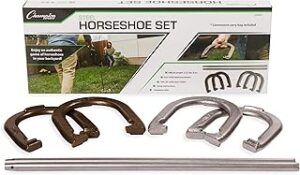The Rules of Horseshoe Pitching: Everything You Need to Know for Backyard or Competitive Play
Horseshoe pitching may seem like a simple toss-and-score game, but there’s more to it than meets the eye. Whether you’re playing a relaxed backyard match or entering a local league, understanding the rules of horseshoe pitching can take your game to the next level.
In this article, we’ll break down the official rules (based on NHPA guidelines), clarify backyard-friendly modifications, and explain everything from pitching distances and scoring to foul lines, game length, and match formats.
Let’s get your game not only fun—but fair and official.
🧱 What Is Horseshoe Pitching?
At its core, horseshoe pitching is a game where two players (or teams) take turns tossing metal horseshoes toward a stake in the ground. The goal? Land your horseshoe as close to the stake as possible—preferably in a way that encircles it (called a “ringer”).
The game requires skill, strategy, and consistency, making it enjoyable for all ages and competitive levels.
🧍 Basic Game Structure: Singles vs Doubles
There are two main ways to play horseshoes:
➤ Singles:
- Two players compete against each other.
- Each throws two horseshoes per inning.
- Players pitch from opposite ends of the court and alternate sides after each inning.
➤ Doubles:
- Two teams of two players each.
- One player from each team pitches from opposite stakes.
- Players switch turns throwing two shoes each.
- The other teammates are stationed at the opposite end and alternate in the next inning.
📏 Horseshoe Court Dimensions & Setup
Official games follow strict NHPA regulations, but backyard players often adjust to fit space and skill level.

➤ Court Layout (Regulation):
- Distance between stakes: 40 feet (measured front-to-front)
- Stake height: 15 inches above ground
- Stake angle: Tilted backward at 12–15 degrees
- Pit size: 43” long by 31” wide (minimum)
- Pitcher’s box: 6 feet wide by 3 feet deep, on both ends
➤ Backyard Adjustments:
- Reduce the distance to 30–35 feet for casual adult games.
- For kids or seniors, you can shorten it further to 20–25 feet.
- Use chalk, tape, or rope to mark foul lines and pitcher’s boxes.
Pro Tip: Always double-check your measurements before starting a game. A level, properly spaced setup means fairer, more enjoyable play.
🧍♂️ Pitching Rules & Technique Basics
Once you’ve got the court set up, here’s how to play correctly.
➤ The Pitch:
- Each player throws two horseshoes per inning.
- You must stand within the pitcher’s box and behind the foul line.
- Throws must be underhand (though there’s no rule against tossing high or flat—it’s all about accuracy and control).
➤ Foul Line Rules:
- Men 18–70: Pitch from 40 feet.
- Women, juniors (12–18), and men 70+: Allowed to pitch from 30 feet.
- Children under 12: May pitch from closer distances, usually 20 feet.
If a player crosses the foul line before releasing the horseshoe, that throw is considered a foul and scores no points.
🎯 Horseshoe Scoring Rules
Scoring is what makes horseshoe pitching competitive. Here’s a breakdown of how points are awarded:
➤ Basic Scoring:
- Ringer (3 points): A horseshoe that completely encircles the stake.
- Closest shoe (1 point): If no ringers are scored, the shoe closest to the stake earns 1 point.
- Both shoes closer (2 points): If both of your shoes are closer than your opponent’s, you earn 2 points.
- Two ringers (6 points): If you land two ringers and your opponent scores none, you earn 6 points.

➤ Cancellation Scoring:
This is the most common scoring format in league and tournament play.
- If both players land ringers, they cancel each other out.
- Only unmatched ringers or closest non-ringers are counted.
- Only one player can score points per inning.
Example: If Player A scores one ringer (3 points) and Player B scores two ringers (6 points), Player B gets 3 points for that inning.
🧮 Game Length and Winning the Match
➤ Point Game:
- Games are often played to 21 or 40 points.
- First player (or team) to reach the target score wins.
- Some tournaments require an exact score to win; others allow players to exceed it.
➤ Shoe Limit Game:
- Instead of points, play a predetermined number of innings (e.g., 20 innings).
- The player with the highest total score at the end wins.
➤ Tie-Breaker:
- If the score is tied at the end of a shoe-limit game, players pitch an extra inning to determine the winner.
Backyard Tip: Keep it simple for casual games—play to 21 with cancellation scoring and allow do-overs for beginners or kids.
🚫 Common Horseshoe Rule Violations
Knowing what not to do is just as important as knowing how to play.
❌ Foul Throws:
- Throwing from outside the pitcher’s box or across the foul line.
- Not completing your throws in the designated inning order.
- Pitching out of turn or interfering with another player’s toss.
❌ Equipment Misuse:
- Using horseshoes that don’t meet agreed-upon size or weight rules (in competitive play).
- Tampering with the court or stakes during a match.
❌ Scoring Misunderstandings:
- Awarding points to both players in an inning (not allowed in cancellation scoring).
- Confusing “leaners” (shoes that lean on the stake) with ringers—they’re only worth 1 point if closest.
🔄 Horseshoe Game Formats and Rule Variations
Want to keep things interesting? Try one of these popular game styles with their own twist on the rules.
➤ Round Robin
- Everyone plays everyone once. Track wins and total points.
➤ Double Elimination
- Lose once and drop to a secondary bracket. Lose twice, and you’re out.
➤ Team Relay
- Teams of 3+ rotate after every throw. Great for parties and large groups.
➤ Kids or Family Rules
- Shorter distances.
- Non-regulation shoes.
- Points awarded for participation or fun achievements.
🧠 Tips for Teaching the Rules to New Players
If you’re introducing new people to horseshoe pitching, make the rules simple and approachable.
- Focus on core basics: foul lines, scoring, and stance.
- Use visual aids: mark foul lines with tape, and post a scoring chart nearby.
- Allow practice throws before official games begin.
- Explain that leaners aren’t ringers, and ringers must circle the stake entirely.
- Use team formats to help new players pair up with more experienced ones.
Create a laminated “quick rule card” for backyard games. It saves time and reduces confusion.
📋 Gear and Setup Rules for Regulation Play
Planning to host or participate in a competitive match or tournament? Here’s what’s required.
➤ Horseshoes:
- Weight: Between 2 lbs 8 oz and 2 lbs 10 oz
- Length: Up to 7 ¼ inches wide
- Material: Steel or ductile iron (rubber for kids/family play)

Horseshoe Game Set
➤ Stakes:
- Diameter: 1 inch
- Height: 15 inches above pit surface
- Angle: 12–15 degrees backward
➤ Pit Surface:
- Most official pits use clay, but sand is fine for backyard play.
- Pit dimensions should match official sizes (43” x 31”).
🏁 Final Thoughts: Master the Rules, Maximize the Fun
Whether you’re gearing up for tournament play or setting the stakes for a family cookout, understanding the rules of horseshoe pitching helps you play smarter, score more fairly, and enjoy the game to its fullest.
From distances and scoring to foul line etiquette and gameplay formats, these rules provide structure to a game rooted in tradition and skill. Once you’ve mastered the basics, you can customize formats to match your players, your yard, and your vibe.
So grab those horseshoes, mark those lines, and pitch with confidence—because when everyone plays by the same rules, everyone has more fun.
🔜 Up Next: The Ultimate Guide To Setting Up A Horseshoe Game At Home
Think you’re ready to organize weekly games or get the whole neighborhood involved? Our next article will walk you through The Ultimate Guide To Setting Up A Horseshoe Game At Home.

Larry Mac
Hi there, and thanks for stopping by! My name is Larry, and I’m the voice behind PlayingHorseshoes.com I love the game and have been playing since I was a kid. I started this blog because I am passionate about the sport, and with all the technology, I hope the sport don’t die. I plan to do my part to keep it going for me and my brother’s sake. Thanks for stopping by, feel free to subscribe and comment. Thank You!


